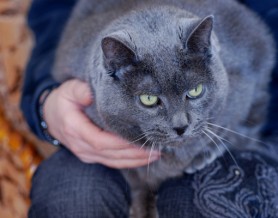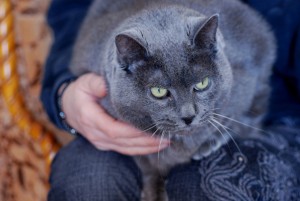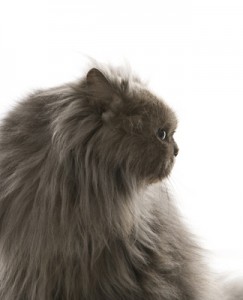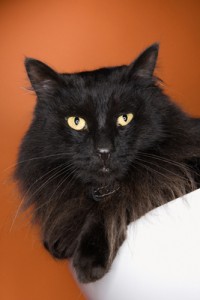Feline Heart Disease

 Cats are a totally different animal than dogs. In dogs, heart disease is more of a primary disease, whereas in cats it is more likely to be a secondary disease. In cats, heart disease is usually caused by some other underlying disease. Since heart disease is a common term for anything that makes the heart not function properly, this article will concentrate only on hypertrophic cardiomyopathy, hyperthyroid disease, hypertension, and thromboembolism.
Cats are a totally different animal than dogs. In dogs, heart disease is more of a primary disease, whereas in cats it is more likely to be a secondary disease. In cats, heart disease is usually caused by some other underlying disease. Since heart disease is a common term for anything that makes the heart not function properly, this article will concentrate only on hypertrophic cardiomyopathy, hyperthyroid disease, hypertension, and thromboembolism.
When you bring Fluffy in for her annual exam, the doctor always listens to her heart. This is one of the many reasons that an annual exam is important. The doctor will listen to Fluffy’s heart for any unusual sounds that could be diagnosed as heart murmurs or arrhythmias. A heart murmur makes a swishing sound because of abnormal blood flow through the heart chambers. If the doctor hears a heart murmur it is graded 1 through 6, (6 being the worst), to establish a baseline for future monitoring. An arrhythmia is an irregularity of the heart rate. It can occur because of a fast or slow heart rate or one that does not beat in a regular pattern. The doctor can then use further testing such as bloodwork, x-rays, ultrasound, and Doppler to diagnose Fluffy’s heart condition.
 Hypertrophic cardiomyopathy (HCM) is a disease of the heart muscle that causes the walls to thicken and become stiff. This impedes the heart’s ability to constrict, so the heart tries to speed up to help the blood flow through the heart. This creates a murmur. These cats can be presented with weakness, panting, and vomiting. This disease usually occurs in cats over 5 years. Unfortunately, there are some breeds that have a genetic disposition toward HCM, including Maine Coon cats and Persians. Bloodwork is required to rule out hyperthyroidism or any other underlying cause. X-rays and ultrasound are used to confirm the diagnosis. Treatment for these cats is oral medicine and special diets. Even with treatment, these cats will be more lethargic and have a shorter life expectancy.
Hypertrophic cardiomyopathy (HCM) is a disease of the heart muscle that causes the walls to thicken and become stiff. This impedes the heart’s ability to constrict, so the heart tries to speed up to help the blood flow through the heart. This creates a murmur. These cats can be presented with weakness, panting, and vomiting. This disease usually occurs in cats over 5 years. Unfortunately, there are some breeds that have a genetic disposition toward HCM, including Maine Coon cats and Persians. Bloodwork is required to rule out hyperthyroidism or any other underlying cause. X-rays and ultrasound are used to confirm the diagnosis. Treatment for these cats is oral medicine and special diets. Even with treatment, these cats will be more lethargic and have a shorter life expectancy.
Hyperthyroid disease is caused by an over-production by the thyroid gland. This is usually caused by a tumor on the thyroid gland. The cats affected by this are usually greater than 6 years of age. These cats are usually underweight, hyperactive, eat more than normal without gaining weight, and have muscle weakness. When these cats come in for exams, they are often found to have heart murmurs or arrhythmias and in some cats we can even feel the tumor in the neck. A blood test is necessary to diagnose this disease.
There are three main ways to treat hyperthyroidism; oral medication, radiation, and surgery. The oral medication is given twice a day for the rest of the cat’s life. Periodic rechecks are then necessary to make sure the disease stays in remission. Radiation is given by a certified veterinarian and requires the cat to stay at a specialty clinic for about 1 week. Surgery can be performed by a veterinary specialist. Most people either go with oral medication or the radiation treatment, especially if the cat is hard to pill.
 Hypertension is high blood pressure and is almost always associated with heart disease, hyperthyroidism, or kidney disease. Symptoms may include a rapid heart rate, dilated pupils that do not respond to light, and sometimes sudden blindness. On exam, the cat will often have a heart murmur. Hypertension is becoming more evident in the feline population as veterinarians know what to look for and cats are living longer lives. Treating the underlying disease can help with the hypertension, along with certain diets and oral medication.
Hypertension is high blood pressure and is almost always associated with heart disease, hyperthyroidism, or kidney disease. Symptoms may include a rapid heart rate, dilated pupils that do not respond to light, and sometimes sudden blindness. On exam, the cat will often have a heart murmur. Hypertension is becoming more evident in the feline population as veterinarians know what to look for and cats are living longer lives. Treating the underlying disease can help with the hypertension, along with certain diets and oral medication.
Thromboembolism is when a clot forms in the chamber of the heart and then flows out with the blood to a vessel, becomes lodged, and blocks the vessel. This is usually fatal. The most common location for the clot to lodge is in arteries to the rear legs. Many times the owner will find the cat suddenly collapsed in the house. When the cat is presented, it will have extreme pain, usually in the rear legs, and weak or absent pulses in the rear legs. They also have murmurs and/or arrhythmias. The treatment consists of blood thinners to try to dissolve the clot and pain medicine. Even with treatment, the outlook is poor. There is not a good prognosis for these cats, but medical science is always improving.
Just because a cat has these symptoms does not always mean it has heart problems, but it is a good idea to get your cat checked annually so the doctors have a chance of finding abnormalities early.

